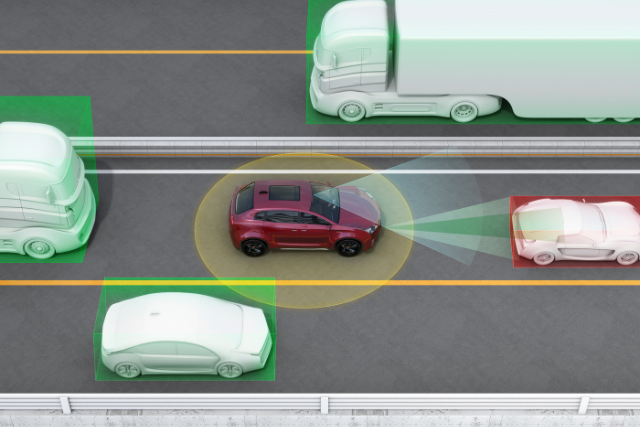Advanced Driver Assistance Systems (ADAS) refer to electronic technologies that assist drivers in driving and parking functions.
These systems enhance vehicle safety and improve road traffic efficiency by utilizing sensors, cameras, and data processing units to detect environmental conditions and provide appropriate responses.
Examples of ADAS include adaptive cruise control, lane departure warning, blind-spot detection, and automatic emergency braking.
ADAS technologies are critical in reducing traffic accidents, fatalities, and injuries. By assisting drivers in making informed decisions and reacting promptly to potential hazards, ADAS helps mitigate human errors, the leading cause of road accidents.
The widespread adoption of ADAS can significantly enhance road safety and contribute to achieving Vision Zero—a global initiative to eliminate traffic fatalities and severe injuries.
The Role of Government Policies in ADAS Adoption
Regulatory Frameworks and Standards
Establishing Safety Standards
Governments play a pivotal role in setting safety standards for vehicle manufacturing, including integrating ADAS.
Regulatory bodies such as the National Highway Traffic Safety Administration (NHTSA) in the United States and the European New Car Assessment Programme (Euro NCAP) in Europe have established stringent safety standards that mandate the inclusion of specific ADAS features in new vehicles.
These regulations ensure that vehicles meet minimum safety requirements, accelerating ADAS adoption.
Compliance and Certification
Compliance with regulatory standards is essential for automakers to sell their vehicles in specific markets. Governments enforce compliance through certification processes that verify the integration and functionality of ADAS technologies.
For instance, the Euro NCAP’s rating system evaluates vehicles based on their safety performance, including the effectiveness of ADAS features.
High safety ratings incentivize automakers to incorporate advanced ADAS technologies to meet regulatory standards and attract consumers.
Incentives and Subsidies
Financial Incentives for Manufacturers
Governments can promote the adoption of ADAS by offering financial incentives to automakers. Subsidies, tax credits, and grants can reduce the financial burden on manufacturers, encouraging them to invest in the research and development of ADAS technologies.
These incentives can accelerate the production and integration of ADAS, making them more accessible to consumers.
Consumer Incentives
In addition to incentivizing manufacturers, governments can also provide financial benefits to consumers who purchase vehicles equipped with ADAS.
Tax rebates, reduced registration fees, and insurance discounts can make ADAS-equipped cars more affordable and attractive to buyers.
By lowering the cost of ownership, these incentives can drive consumer demand for ADAS, fostering widespread adoption.
Public Awareness and Education
Campaigns and Initiatives
Public awareness campaigns and educational initiatives are crucial for promoting the benefits of ADAS to consumers.
Governments can collaborate with automotive manufacturers, non-governmental organizations, and educational institutions to launch campaigns highlighting ADAS’s safety advantages.
These initiatives can educate drivers about the functionality of ADAS, how to use these systems effectively, and the potential impact on road safety.
Training Programs
Governments can also implement training programs to enhance drivers’ understanding of ADAS technologies.
Driver education programs can include modules on the operation and benefits of ADAS, ensuring that drivers are well-informed about the systems integrated into their vehicles.
By increasing awareness and understanding, these programs can build consumer confidence in ADAS, encouraging adoption.
Impact of Government Policies on ADAS Market Growth
Market Penetration and Expansion
Boosting Market Penetration
Government policies that mandate integrating ADAS features in new vehicles can significantly boost market penetration.
For example, regulations requiring automatic emergency braking and lane-keeping assistance in all new cars can rapidly increase the adoption of these technologies.
As more vehicles on the road are equipped with ADAS, the market penetration of these systems will grow, contributing to overall road safety.
Encouraging Technological Innovation
Supportive government policies can foster technological innovation in the automotive industry. Research and development grants, tax incentives, and subsidies can encourage automakers and technology companies to invest in developing advanced ADAS technologies.
This innovation can lead to the creation of more sophisticated and effective ADAS solutions, further driving market growth.
Economic and Environmental Benefits
Economic Impact
Adopting ADAS can have significant economic benefits, including reducing the costs associated with traffic accidents. By minimizing collisions and related damages, ADAS can lower healthcare expenses, insurance claims, and vehicle repair costs.
The growth of the ADAS market can create job opportunities in the automotive and technology sectors, contributing to economic development.
Environmental Impact
ADAS technologies can also contribute to environmental sustainability by improving traffic flow and reducing fuel consumption.
Features such as adaptive cruise control and traffic jam assist in optimising driving patterns, leading to more efficient fuel usage and reduced emissions.
Governments prioritising the adoption of ADAS can align their policies with environmental goals and promote greener transportation solutions.
Case Studies: Government Policies Driving ADAS Adoption
United States
NHTSA Regulations
The NHTSA has implemented several regulations to promote the adoption of ADAS in the United States. The agency has mandated the inclusion of rearview cameras in all new vehicles to enhance visibility and prevent backover accidents.
The NHTSA’s New Car Assessment Program (NCAP) also includes ratings for ADAS features, encouraging manufacturers to integrate advanced safety technologies.
Financial Incentives
The U.S. government offers tax credits and rebates for electric and hybrid vehicles with advanced safety features, including ADAS. These financial incentives make ADAS-equipped cars more affordable for consumers, driving adoption and market growth.
European Union
Euro NCAP Standards
The Euro NCAP has been instrumental in promoting the adoption of ADAS in Europe through its stringent safety rating system.
The program assesses vehicles based on their safety performance, including the effectiveness of ADAS technologies such as autonomous emergency braking and lane-keeping assistance.
High safety ratings incentivize automakers to integrate advanced ADAS features to achieve favourable ratings.
Legislative Measures
The European Union has introduced several legislative measures to mandate the inclusion of ADAS in new vehicles.
Regulations require all new cars sold in the EU to be equipped with advanced safety features like automatic emergency braking and intelligent speed assistance by a specified date.
These measures ensure that ADAS technologies become standard in vehicles, accelerating adoption.
Japan
Government Initiatives
The Japanese government has launched initiatives to promote the development and adoption of ADAS technologies.
The Ministry of Land, Infrastructure, Transport and Tourism (MLIT) collaborates with automakers and technology companies to advance ADAS research and development.
Japan has introduced subsidies and tax incentives for vehicles with advanced safety features, encouraging consumer adoption.
Public Awareness Campaigns
Japan has implemented public awareness campaigns to educate drivers about the benefits of ADAS. These campaigns highlight the safety advantages of ADAS technologies and provide information on how to use them effectively.
The government aims to build consumer confidence and drive adoption by increasing public awareness.
Challenges and Considerations
Technological and Infrastructure Challenges
Integration and Compatibility
Integrating ADAS technologies into vehicles requires seamless compatibility between various components, including sensors, cameras, and data processing units.
Ensuring these components work together effectively can be challenging, especially as new technologies emerge.
To address these challenges, governments must establish standards and guidelines for integration and compatibility.
Infrastructure Readiness
The effectiveness of certain ADAS features, such as adaptive cruise control and lane-keeping assistance, depends on well-maintained road infrastructure.
Clear lane markings, road signs, and traffic signals are essential for the accurate functioning of ADAS. Governments must invest in infrastructure improvements to support the widespread adoption of these technologies.
Privacy and Security Concerns
Data Privacy
ADAS technologies collect and process significant data, including information about the vehicle’s surroundings, driver behaviour, and location.
Ensuring the privacy and security of this data is crucial to gaining consumer trust. Governments must establish regulations and standards for data protection to address privacy concerns and prevent unauthorized access.
Cybersecurity
As vehicles become more connected and reliant on digital technologies, they become vulnerable to cybersecurity threats.
Hackers could potentially gain control of ADAS features, posing safety risks to drivers and passengers.
Governments must implement cybersecurity measures and standards to protect ADAS-equipped vehicles from cyberattacks.
Economic and Social Considerations
Cost and Affordability
The cost of developing and integrating ADAS technologies can be high, leading to increased vehicle prices.
While government incentives can offset some of these costs, affordability remains a concern for many consumers.
Policymakers must balance promoting ADAS adoption and ensuring these technologies are accessible to a broad range of consumers.
Equity and Accessibility
Ensuring that all population segments have access to ADAS technologies is essential for promoting road safety.
Governments must consider equity in their policies, ensuring that low-income and marginalized communities benefit from advancements in vehicle safety.
This may involve targeted incentives and programs to make ADAS-equipped vehicles more accessible to diverse populations.
Future Outlook and Recommendations
Advancing Government Policies
Continuous Policy Development
Governments must continuously update and refine their policies to keep pace with advancements in ADAS technologies.
Regular reviews of safety standards, incentives, and regulatory frameworks are essential to address emerging challenges and promote innovation.
Policymakers should engage with industry stakeholders, researchers, and consumers to ensure policies remain relevant and effective.
International Collaboration
Collaboration between governments on an international level can facilitate harmonising ADAS standards and regulations.
This can enhance the global adoption of ADAS by ensuring that vehicles equipped with these technologies meet consistent safety and performance criteria across different markets.
International cooperation can also support the exchange of best practices and lessons learned.
Promoting Public-Private Partnerships
Industry Collaboration
Public-private partnerships can drive the development and adoption of ADAS technologies. Governments can collaborate with automotive manufacturers, technology companies, and research institutions to advance ADAS research, development, and deployment.
These partnerships can leverage the expertise and resources of both the public and private sectors to achieve common goals.
Funding and Investment
Governments can provide funding and investment opportunities to support the growth of the ADAS market. This includes grants for research and development, investment in infrastructure improvements, and financial incentives for consumers and manufacturers.
By fostering a supportive investment environment, governments can accelerate the adoption of ADAS technologies.
Enhancing Public Awareness and Education
Ongoing Education Campaigns
Continuous education campaigns are essential to keep the public informed about the benefits and functionality of ADAS.
Governments should invest in ongoing campaigns that provide up-to-date information on new ADAS features, safety benefits, and effective use of these technologies.
These campaigns can build consumer confidence and drive adoption.
Driver Training Programs
Incorporating ADAS training into driver education programs can enhance drivers’ understanding and effective use of these technologies.
Governments can work with driving schools and licensing authorities to integrate ADAS modules into training curricula.
By equipping drivers with the knowledge and skills to use ADAS, these programs can maximize the safety benefits of these systems.
Conclusion
Summary
Government policies are crucial in influencing the adoption of Advanced Driver Assistance Systems (ADAS).
Through regulatory frameworks, financial incentives, public awareness campaigns, and international collaboration, governments can drive the integration and acceptance of ADAS technologies.
These policies enhance road safety and contribute to economic growth, environmental sustainability, and technological innovation.
Final Thoughts
As the automotive industry continues to evolve, governments must remain proactive in developing and implementing policies that support the widespread adoption of ADAS.
By addressing technological, economic, and social challenges, policymakers can create an environment that fosters innovation and ensures that the benefits of ADAS are accessible to all.
The future of road safety depends on the collective efforts of governments, industry stakeholders, and consumers to embrace and advance ADAS technologies.







